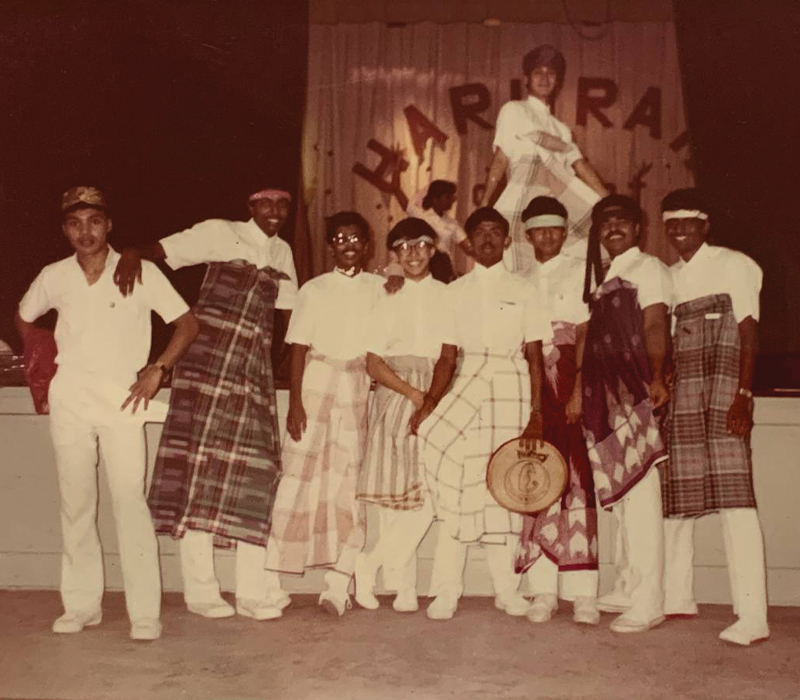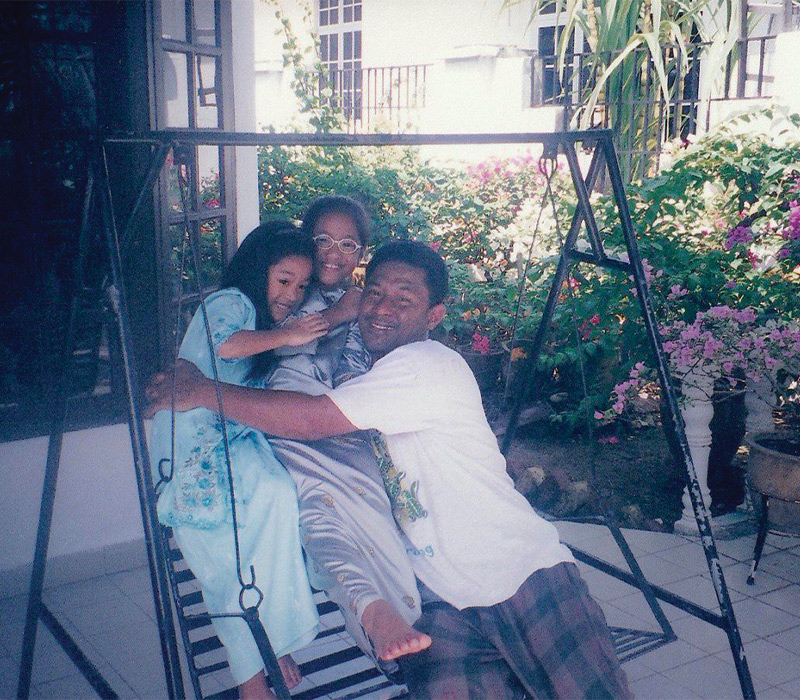For most Malay families, the kain pelikat is a familiar sight. To those unaware, it is a long, checkered cloth usually wrapped around the hip or waist. Once secured with a knot, it takes a tubular shape akin to a long skirt. Design-wise, it is simple and uncomplicated, mostly existing in geometrical motifs of squares, rectangles and lines. Some might even label it as the male version of a sarong because it serves the same purpose of easy, effortless homewear. Even so, the kain pelikat remains a sentimental piece for most Malay families for it was always worn—and is still worn—by many Malay men and fathers to this day.
Growing up, I remember my father wearing it for both errands and family events. From eating a Sunday meal of nasi lemak to fixing the faulty lightbulb in the kitchen, he was always unabashedly clad in it. Casual birthday parties were no exception. He would confidently turn up wearing one paired with a (mismatched) batik blouse. “I look good, right?” he proudly quipped.
During one of our family trips to London, in the middle of a grueling winter, I found my father standing in the middle of the apartment corridor wearing the kain pelikat. I began to suspect how much the garment meant to him. And true enough, he described it as “a piece of history” that he could hold on to. Having worn it from the tender age of 10, during his adolescent years, and even after marriage, he states that it is multigenerational. Just like how I have seen it on my father, he has seen it on his, too. “This is my safety blanket and keeps me close to my roots,” he mentioned.

Origins of the kain pelikat
For the uninitiated, the kain pelikat originated in the 17th century from a region in Southern India called Pulicat or Pazhaverkadu. The Dutch exported the fabric from India to Southeast Asia, and it was adopted by the local communities, typically worn by Malay men. Soon enough, it became an unspoken rule for males to wear it at the mosque, particularly for Friday prayers. “You would notice a swarm of men wearing their own kain pelikats. Some pair them with tucked-in shirts while others wear a loose tunic over it. It was everyone’s go-to,” recalled my father.
Also evocative of the kampung spirit, my father felt proud wearing the kain pelikat. He always referenced the titular characters from classic P. Ramlee films Bujang Lapok and Hang Tuah’s wardrobe that were of similar vein. Even till this day, he feels an innate sense of Malay consciousness and nostalgia while watching these films where time back then, to him, was simple and wholesome. Similarly, actor-comedian Harith Iskander in Sepet was also clad in the unique cloth; a defining movie of its time that zeroed in on stereotypes behind interracial relationships and Malay families. Not to mention, the 2015 hit track Kain Pelikat by Anuar Zain waxed lyrical about the cloth’s multifunctional purposes as baby swings, curtains, and bed sheets. Over and above, the kain pelikat’s influence is prominent and far-reaching. The well-beloved cloth can also be found in other regions: wizaar in Oman; dhoti in West Bengali; kanga in East Africa; malong in Philippines; and others.

Why is it so comfortable?
A good quality kain pelikat should tick a few boxes: finely threaded, moisture-absorbent, and comfortable. The best pieces are thin but opaque, adjustable to any body size, and made of cooling 100% cotton. My father gauges the quality of a good kain pelikat via the old-fashioned, but foolproof way—physically putting it on your skin and doing a few opacity checks.
As far as design is concerned, he finds the aesthetics of the kain pelikat to be a secondary priority. “As long as you feel comfortable in it, wrap it tightly, and go on about your day, that’s the only thing that matters.”
To my father, the many pros of wearing the cloth was that it was fuss-free and largely easy to wear. As taught by his own ayah (father in Malay), tying the kain pelikat required some practice. Namely, parting the cloth in a way that does not compromise movement nor reveal excessive skin. “Once you know how to tie it, you can wear it with your eyes closed. Next thing you know, you would be gallivanting like me to climb trees and then going around to jolok (bringing down) fruits.”


PELIKAT.: the modern alternative
Nowadays, the kain pelikat is deemed to be old school and incompatible for modern wear. However, up-and-coming designer Mazri Ismail, 27, aims to counter that with PELIKAT.—a collection of kain pelikats worn in fashion-forward ways that deconstructs and elevates the traditional garment.
“I see my father wearing the kain pelikat at home almost everyday. I wanted to push gender fluidity in this collection as it is regarded to be a masculine fabric amongst the Malay community,” Ismail shared.

Expertly weaving function and fashion, PELIKAT. experiments with oversized, boxy silhouettes to harness a conceptual and avant-garde look. At the same time, the sophisticated draping along the body exudes softness and gentility; reflective of the fluidity of the designs. Designed for easy wearing, Ismail masterfully scales down any extravagance by using accessible and basic fastening mechanisms such as zippers and buttons—a more approachable way to tie the kain pelikat in modern times.
When it comes to heritage and tradition, Ismail found it crucial to respect the unique cloth. “It is a prominent fabric within the Malay community. As such, this attention to history and culture was my absolute top priority when it came to any form of design adjustment and alteration.” He also expressed that it was a big challenge whilst designing the collection. “I changed designs countless times as I struggled finding the middle ground between fashion trends and respecting the culture.”

Nevertheless, PELIKAT.’s strength lies in its ability to evoke nostalgia and yearning. In particular, inspiring local communities today to relearn and appreciate the beauty and history of the kain pelikat. To Ismail, the storied cloth has accompanied him through many phases of his life—one of the earliest memories being him wearing it to the mosque. “My dad taught me how to wear the kain pelikat. Till this day, it holds a lot of sentimental value for me by reminding me to stay grounded and rooted. It has also grown to be a part of my identity that I feel a lot of pride for.”





